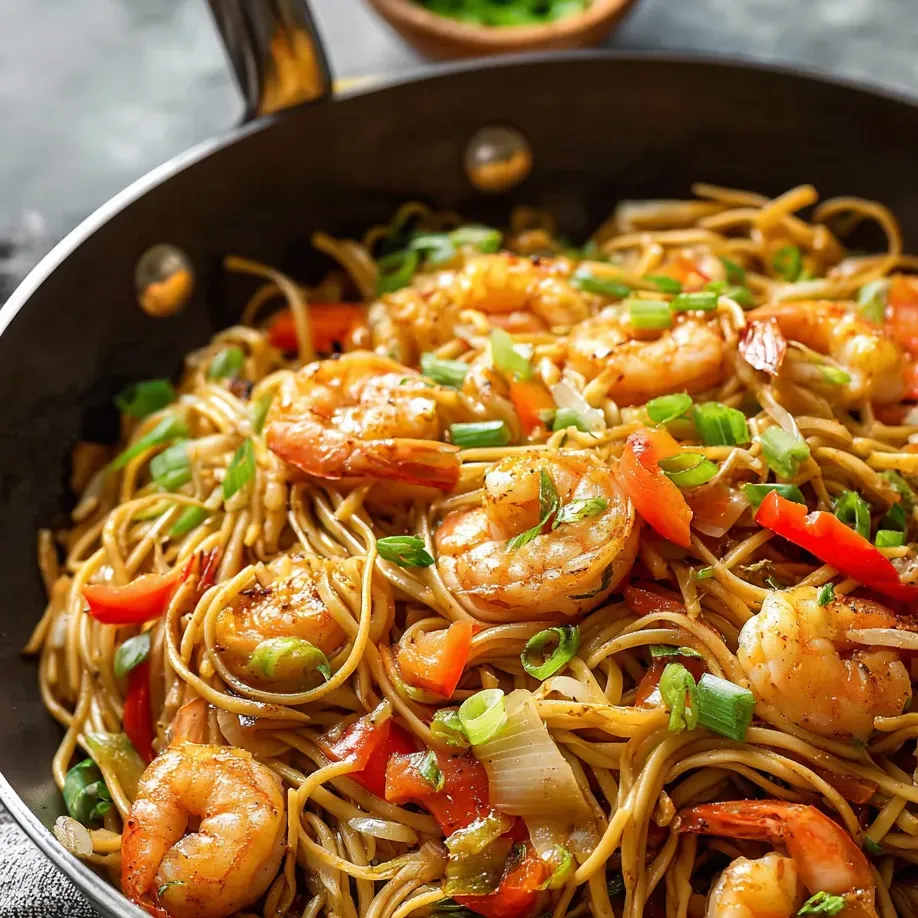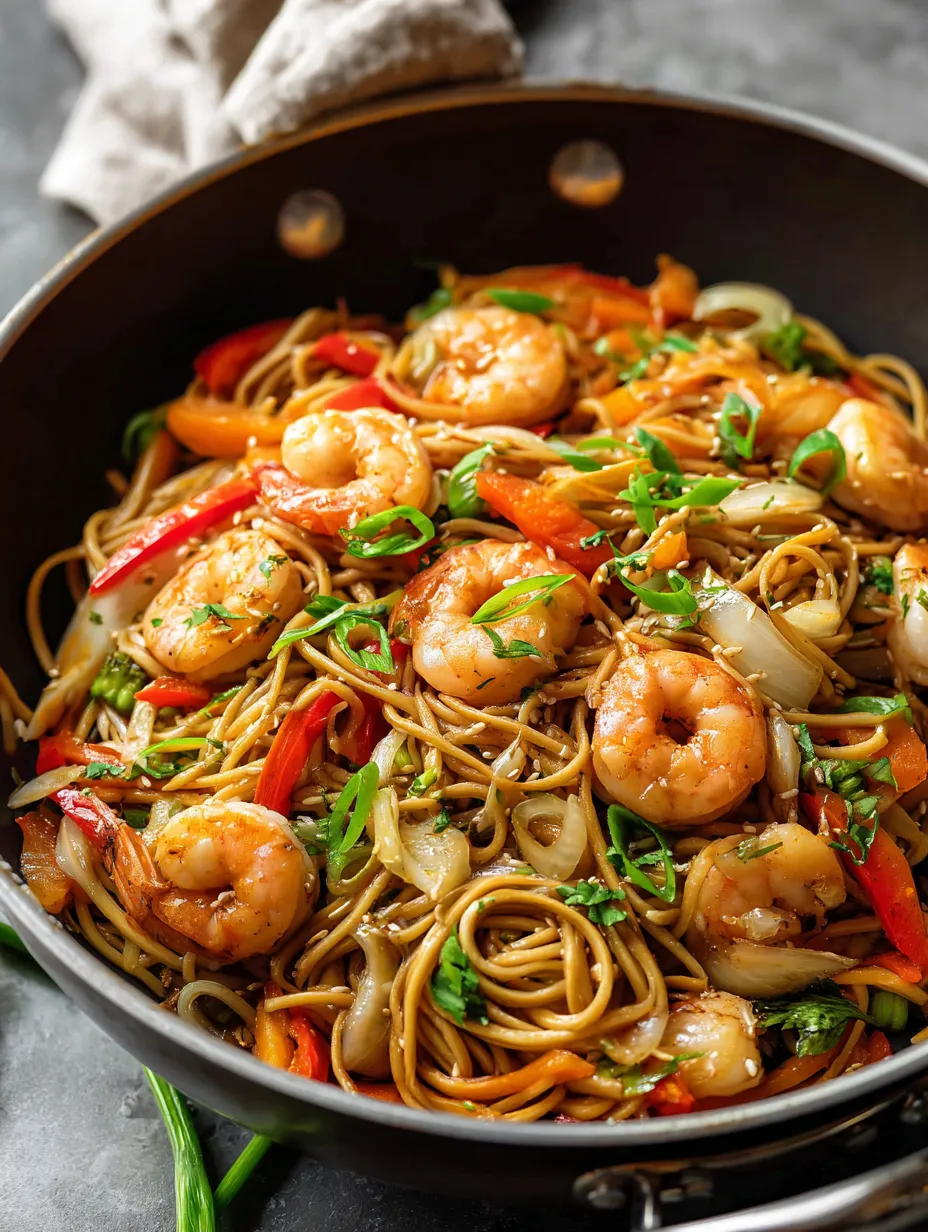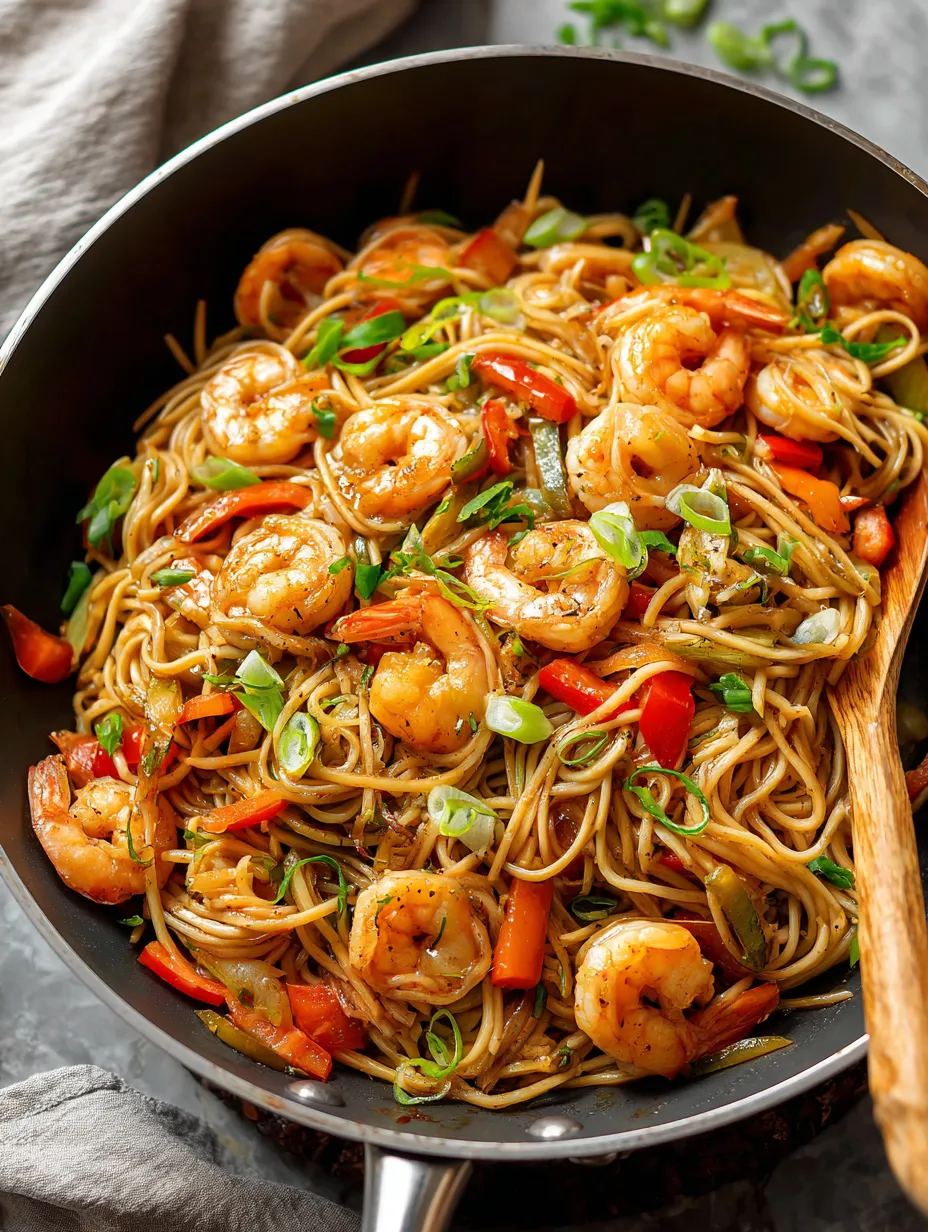 Save
Save
Whip up Shrimp Lo Mein at home and skip the chaos of takeout. Big juicy shrimp get tossed with crunchy veggies and soft noodles, then soaked in a glossy, super flavorful sauce that hits all the right notes. Whenever I want a colorful meal that feels special but doesn't eat up my time, this is my go-to. It's speedy, full of taste, and everyone loves it.
I remember making this Shrimp Lo Mein for a birthday when my family wanted to cook something fun instead of ordering in. Now, it's always requested when we have friends or family over.
Tasty Ingredients
- Big shrimp: Choose firm, bright-smelling shrimp. Thawed frozen ones work too if you dry them well before cooking.
- Lo mein noodles: The classic chewy yellow ones grab that sauce beautifully. Spaghetti works if you can’t find lo mein.
- Green onions: Slice these to sprinkle on at the end for a pop of color and freshness.
- Dry white wine: Adds a touch of acid and helps scoop up those brown bits from the pan. Pick a wine you like to drink.
- Peanut oil or olive oil: Use whichever has a high smoke point for a good sear on shrimp and veggies.
- Red pepper flakes: Totally optional for those who like a little heat.
- Ground ginger: Adds a cozy warmth. Grate fresh ginger if you’ve got it for even more zing.
- Sesame oil: A little splash gives deep nutty flavor. Toasted is best for full impact.
- Sriracha: Turns up the heat a notch. Any favorite hot sauce does the job.
- Fresh garlic: Mince up plump cloves to wake up all the flavors. The fresher, the better.
- Cornstarch: Helps turn the sauce thick and glossy. Mix it into something cold first so it’s lump-free.
- Honey: Just enough to make things balanced and not too salty.
- Hoisin sauce: Gives depth and a little sweetness to the sauce.
- Soy sauce: Splash in plenty for that classic umami taste. It’s worth using good stuff here.
- Chicken broth: All the saucy flavor builds off a good broth. Low sodium if you want to manage the saltiness.
- Bean sprouts: Crisp and fresh, these add the classic lo mein bite. Fresh is ideal; canned works after a rinse.
- White onion: For that gentle, savory crunch. Swap for yellow onion if that’s handy.
- Celery: Crunchy and fresh, giving the noodles a nice lift.
- Carrots: Sliced into thin sticks for sweet crunch and quick cooking.
- Red bell pepper: Shiny and sweet, these bring a nice pop of color. Pick firm ones without spots.
- Green cabbage: Chopped and tossed in for sweetness and crunch. Look for tightly packed heads to keep things crisp.
Easy Instructions
- Finish with Shrimp:
- Pop the shrimp back in and let them warm up for a minute or two. Sprinkle green onions on top just before serving for a bright touch.
- Add Bean Sprouts and Noodles:
- Toss bean sprouts into the skillet, followed by your noodles. Add them in slowly so they all get coated with sauce. Let it sit for a minute to soak up all the flavors.
- Combine Sauce and Veggies:
- Give the sauce a quick mix and pour it over your veggies. Crank up the heat so it boils and thickens up. Once glossy, turn the heat down low.
- Sauté the Vegetables:
- Toss onion, bell pepper, carrot, celery, and green cabbage into the skillet. Stir these for four or five minutes until just soft and still super bright.
- Cook the Noodles:
- Boil your lo mein noodles, but pull them off the heat a minute before they’re fully done. Stir now and then to keep them loose, then drain and either drizzle with oil or set aside.
- Deglaze with Wine:
- Turn the stove off, pour the wine into the pan, and scrape up any brown bits. Turn the heat back on and cook until the wine’s cut down by half, about four minutes.
- Sear the Shrimp:
- Heat oil in your big skillet over fairly high heat. Spread shrimp in one layer. Sear just over a minute per side and remove fast—they’ll finish cooking in the sauce.
- Prep the Shrimp:
- If your shrimp are frozen, thaw and dry ‘em. Peel off shells (and tails, if you want) and take out the vein. Leaving the shells on for cooking makes them extra juicy, but it’s easier to eat when peeled.
- Get the Sauce Ready:
- Pour chicken broth, soy sauce, honey, hoisin, cornstarch, garlic, sriracha, sesame oil, ground ginger, and pepper flakes into a big measuring cup. Whisk until smooth—but keep it cold so nothing thickens yet. Set aside for later.

I always try to dig out those bites packed with bean sprouts and plump shrimp. My family finished a whole pan the first time I made it because the noodles turned out so shiny and rich.
How to store leftovers
Pop any extras into a sealed container, then stick in the fridge for up to three days—or stash in the freezer for three months. For the best results when warming, reheat slowly in a skillet so shrimp don’t get tough. Microwave works, too—just go with low heat and a little patience.
Swaps and subs
Switch up the veggies—throw in mushrooms, broccoli, snow peas, or snap peas. If you’re skipping shrimp, tofu or chicken makes a tasty swap (or even beef strips). Got no chicken broth? Try veggie broth instead.

How to serve it up
Layer on toasted cashews or peanuts for crunch. A few drops of chili oil or more sriracha dials up the spice. Makes a full meal on its own, but pairs nicely with dumplings or a speedy cucumber salad.
A bit of backstory
Lo mein is a staple in Chinese American spots—those chewy noodles tossed in a sweet-savory brown sauce. It gets its big flavors from quick stir-frying over high heat. Making it at home is a team effort that usually has my whole crew sneaking bites over the pan.
Frequently Asked Cooking Questions
- → How do I keep shrimp from getting tough?
Don’t cook shrimp too long—around 1 minute and 20 seconds per side, then get them off the heat fast. Keeping the shells on while you cook helps them stay juicy. Only toss shrimp back in right at the end to warm through.
- → Is there a good swap for lo mein noodles?
You sure can use regular spaghetti noodles instead. Just boil them until they’re a bit firm so they don’t turn mushy when you mix in the sauce.
- → What veggies taste best in here?
Carrots, peppers, celery, cabbage, onion, and bean sprouts all give a nice crunch. Add mushrooms, snow peas, broccoli, or even edamame if you like.
- → How can I make it less salty?
Switch to low-salt soy sauce and broth. Rinse off canned bean sprouts too, so the dish doesn’t get too salty.
- → What's the best way to store and warm up leftovers?
Keep any extra in a sealed container in your fridge for about three days, or toss it in the freezer for up to three months. Make sure to reheat on the stove gently, so your shrimp and noodles don’t overcook.
- → What can I use instead of wine to deglaze?
Chicken broth works just as well, or grab some Shaoxing wine. If you’re swapping liquids, cook off the extra water a little faster if you have to.
